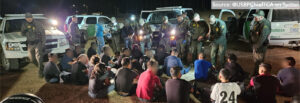Note: This analysis was originally posted on WOLA’s Border Fact Check blog.
Rocks are weapons and constitute deadly force. If an agent is confronted with deadly force they will respond in kind. No agent wants to have to shoot another human being, but when an agent is assaulted and fears for his life then his hand is forced.
—Border Patrol Union statement, “Rock Assaults are Deadly Force”
On Wednesday, October 10, 16-year-old Jose Antonio Elena Rodriguez was killed in downtown Nogales, Mexico when a Border Patrol agent opened fire at a group of people allegedly throwing rocks at him; Rodriguez was shot seven times. Since 2010, at least 15 civilians, the majority Mexican, have been killed in confrontations with Border Patrol agents on the U.S.-Mexico border. In the Nogales area, Rodriguez’s killing was the fifth incident in this same period in which a Border Patrol agent fired bullets or pepper balls at alleged rock throwers. This includes the January 2011 death of 17-year-old Ramses Barron Torres from a gunshot wound after another rock throwing incident.
Just last month, Mexican president Felipe Calderon spoke of the case of Guillermo Arevalo Pedroza, who was on a picnic with his family on the south side of the Rio Grande near Laredo, Texas when he was shot and killed by a bullet from a Border Patrol agent who had been firing at rock throwers on the Mexican side of the border.
In June 2010, 15 year-old Mexican Sergio Adrian Hernandez Guereca was shot to death by an agent of Border Patrol near the U.S. side of the border in El Paso, after a group of teens including him threw rocks at the agent. In February 2012, a federal judge ruled against a lawsuit filed by the boy’s parents alleging that the agent violated the boy’s constitutional protections against deadly and excessive force. The judge affirmed that “Guereca isn’t covered by those protections because he was a Mexican citizen and was in Mexico when the shooting took place.”
On multiple occasions, the Mexican government has condemned the deaths of Mexican citizens killed in these incidents, stating that “the use of firearms to repel rock attacks… represents an excessive use of force.”
According to a Los Angeles Times article, under Customs and Border Protection guidelines, “repelling rock attacks with bullets can be regarded as a justifiable use of force in part because rocks have inflicted serious injuries on agents.” In fact, for fiscal years 2008 to 2010, Border Patrol agents suffered over 750 “rocking assaults” each year during their work to protect the border.
The Facts:
No one questions the Border Patrol agents’ right to defend themselves, particularly as they confront armed drug and human smugglers. However, law enforcement experience offers a series of non-lethal responses to rock throwing incidents along the U.S.-Mexico border. In Occupy movement protests in different California cities over the summer, and just this past weekend in a disturbance caused by skateboarders in Hollywood, protesters threw rocks and bottles at police officers – and yet in these as in most cases, police were able to control the situation without severe injuries, let alone fatalities, on either side. In the use of force continuum, lethal force is the last resort.
For the Border Patrol, other options do exist. In one rock-throwing incident in Nogales in May 2011, the Border Patrol agent fired rounds from a pepper-ball launcher and was able to seize drugs without any injuries on either side of the border. In August 2012, Yuma Border Patrol agents also received training on pepper ball launchers as an alternative to deadly force. To avoid future incidents such as the deaths of Jose Antonio Elena Rodriguez and Guillermo Arevalo Pedroza, Customs and Border Protection should emphasize training on de-escalation techniques on the use of force and provide additional non-lethal options for its agents.

